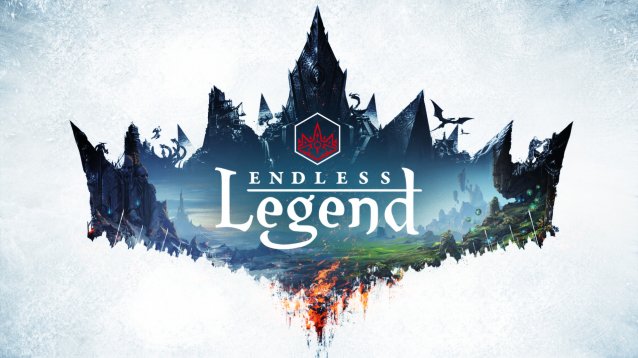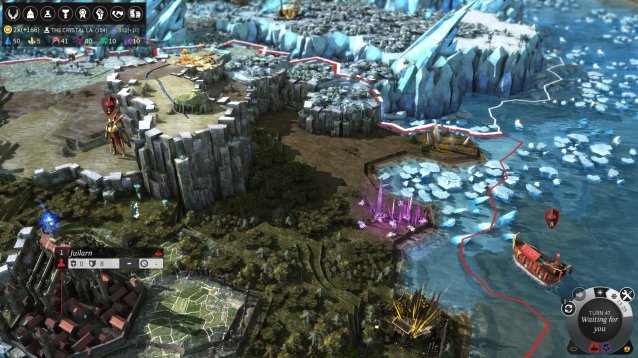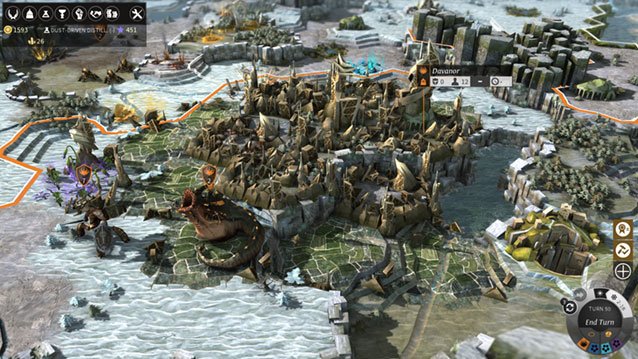


OK, full disclosure. I had no idea the term “4X” was used to define a genre of strategy games. I’ve owned just about every Civilization game in the series, and yet this designation was still new to me. So when I first saw the press release for Endless Legend as a new “4X fantasy-strategy game” I was immediately confused and intrigued. If a 4X strategy game is anything like a jug of moonshine, that means it’s just really, really, good… right?
I enjoy a good strategy game. But I usually need something to grab my attention if I’m going to invest my time. Thankfully, Amplitude Studios appealed to my love of deep fantasy and science fiction lore right off the bat. So after reading a little background on the “Roving Clans” and “Ardent Mages”, and seeing just how deep it got, I knew I had to see what this game was all about.
I hate starting new strategy games. Dumping a few hours just to play a “tutorial” campaign is not my cup of tea. It’s why I’ve been mostly confined to the Civilization series. It’s familiar. It’s easy. And since strategy games have a ridiculous amount of detail to master, I knew I couldn’t jump in and expect to know what I was doing with Endless Legend.
Luckily the tutorial is actually a tutorial and not a faux campaign. It walks you through the first few turns and provides just enough information to not be overwhelming. You get a rundown of the menu system, the basics of founding a city, what you need to know to expand that city, details on army creation and combat, questing and exploration, and an explanation of what to do when encountering other factions. But it’s really just the tip of the iceberg. I was disappointed there was no glossary, but any missing puzzle pieces can be grasped with time spent playing the game.

Now that I was up to speed, the next step was selecting my first faction and world options. My initial attempt at empire building was with the Ardent Mages. I made plenty of mistakes, which was to be expected, but the biggest was not paying attention to the empires strengths and weaknesses. There are eight factions in total, all with rich backstories and different starting technologies to suit a multitude of play styles. Although most technologies can be learned by other empires, each faction has unique traits that will enhance their strategic focus, whether through diplomacy, conquest, or otherwise.
For example, the Roving Clans have traits that focus on economy and they cannot declare war on any empire. While on the other hand, the Necrophages have no means of diplomacy, so they cannot create alliances or maintain peace with other empires. These distinctions make choosing a faction very important depending on how you want your campaign to achieve victory.
World sizes can host campaigns from anywhere between two to eight empires. There are options for multiple continents, various sized Pangaea landmasses, or even a world made up of islands. There’s an incredible amount of customization that can be done with the world’s temperature and topography as well. This will determine the resources available and can provide a variety of new strategic elements.
My biggest joy comes from how greatly combat is affected by these landscape changes. Impassable cliffs, smaller ridges, and even lakes can play a large role when considering proper unit placement on the battlefield. Every skirmish unfolds on the same world map you explore, so it takes a keen sense to determine whether you may be at a disadvantage before any swords begin to swing. This could very well lead to a planned retreat in order to gain higher ground, thus an advantage, which is a tactic that’s hard to come by in most strategy games.
This leads to a great amount of variety when imposing topography changes, thus my favorite campaigns have been in worlds with large mountainous landmasses. And once I learned how to take advantage of other bonuses applied from various terrains, like forest tiles that may increase a unit’s defense, the combat tactics opened up even further.

However, it took me a while to learn the in’s and out’s of Endless Legend’s stratagem. Needless to say, my first campaign was a disaster. I didn’t understand the menu system as well as I’d hoped. But it’s a good thing tooltips are available when you hover over literally anything on screen. It’s a very generous feature and made things infinitely easier, but didn’t do much for screen real estate.
At first glance the interface is very minimalistic. The landscape feels like a focal point and the lack of a heads-up display makes the world feel much more immersive. The landscape is very appealing to look at when first starting out, but those feelings went away the instant I founded my first city. The screen became over-cluttered, and I can see how some might have trouble with it. This is all thanks to an almost complete border of intrusive gray boxes that appear around the screen. It isn’t the most attractive looking interface by any means, but it certainly gets the job done.
Every faction begins with a starting hero, two infantry units, and a settler to found their first major city. The first thing I noticed is the limit to how far you can survey the area before founding that first city. Exploring right away brings the risk of the entire campaign going up in flames. And trust me, I learned this the hard way.
Every empire has a base amount of currency called Dust. Just about everything requires this currency to maintain, and that includes your starting hero and military units. These units cost nine Dust after every turn, and since you only begin with a base amount of fifty you’ll be bankrupt on your sixth turn. Going bankrupt will automatically cause your empire to sell off whatever assets you have available, which includes your starting hero and military units. Thankfully players won’t need to roam very far because the game is balanced enough to have a good mix of resources in starting regions.
After getting off to a bad start in my Ardent Mages playthrough, I wound up annihilated by other factions after only eighty-two turns. It was a good learning experience at the very least, so I was better prepared for my next campaign with the Wild Walkers. Their empire has a small trait bonus that affects industry output, and military units are granted attack and defense bonuses from forest terrain. I still didn’t have a plan for my victory strategy, but this empire made more sense to me after going in blind the first time.

My newfound experience led me to focus my resource production on industry right away. I settled my Wild Walkers in an area with a few “anomaly” terrain tiles to help modify their city’s output, which provide greater “FIDSI” bonuses when settled upon. This is an acronym for Food, Industry, Dust, Science, and Influence, which are the resources your city will generate after every turn, and their output depends highly on how you assign workers to streamline their production.
The city management can be surprisingly satisfying. Some strategy games get boring and become tedious with too much micro-management, but Endless Legend has found a good balance by not becoming so easy to manipulate. Managing a city requires very careful attention. If you let any type of FIDSI production falter too far in one direction it can throw unwanted surprises at you later. Like when the game world changes seasons from summer to winter, also known as the Dark Season in the game’s world of Auriga. During this time the game imposes penalties to a unit’s movement, vision, and all output on food producing terrain tiles. It’s a wonderful change up, and the game only gives a vague timeframe of when the seasons will shift.
After spending a great deal of time with Endless Legend, I walked away very pleased with how drastically different every campaign played out. Amplitude Studios did a fantastic job of creating a 4X strategy game with amazing depth and wonder. The quests add a unique story element to go along with every faction, and the grand scheme within the “Endless Universe”, which now spans across three different games, is something I’ve become very attached to.
If all of this wasn’t enough to suck me in, they’ve also included the ability to create custom factions. Throw this on top of a multiplayer component with up to eight players, and I can see myself dumping endless hours into this incredibly fun game.
9 out of 10
Endless Legend was developed by Amplitude Studios and Published by Iceberg Interactive. It was released on September 18th, 2014, and is available on PC and Mac for $34.99. A PC version of the game was provided by the publisher for this review.




 Why We Need To Have A Discussion About Games Journalism
Why We Need To Have A Discussion About Games Journalism Top 14 GTA 5 Holy Shit Moments
Top 14 GTA 5 Holy Shit Moments Until Dawn Best Ending: How to Keep Everyone Alive
Until Dawn Best Ending: How to Keep Everyone Alive Destiny Bounty Guide For August 28: How To Unlock Iron Banner, Crucible, Vanguard and Other Bounties
Destiny Bounty Guide For August 28: How To Unlock Iron Banner, Crucible, Vanguard and Other Bounties How Nintendo Failed The 3DS
How Nintendo Failed The 3DS